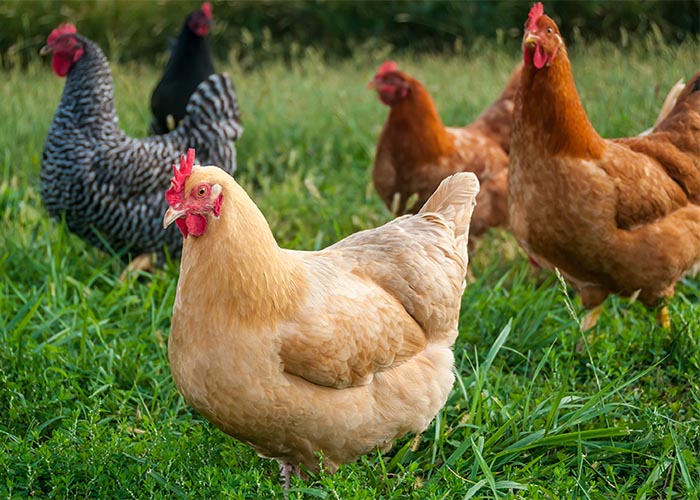
For active homesteaders, dual-purpose chicken breeds are a popular choice. They are known not only for their egg-laying prowess, but also for their tasty meat. This allows small scale poultry farms to live sustainably, and raise a flock that can feed their entire family year-round. We often recommend dual-purpose chicken breeds for many of our first-time chicken owners as well. In this blog, we explore the various breeds of dual-purpose chickens so that you can select the right chicks for your flock.
To learn more about the chicks available in the 2021 season, refer to our Chick Season 2021 page.
Black Giant
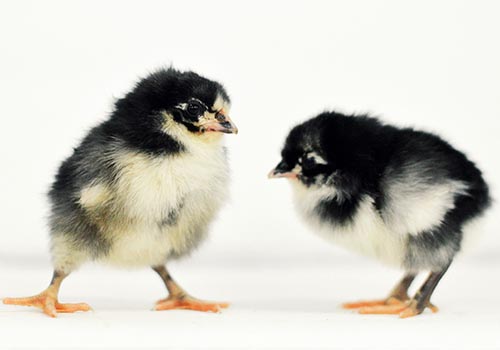
Developed in New Jersey in the late 19th century by crossing several of the large, dark Asiatic breeds, the Black Giant is the largest breed of chicken in the United States and possibly the world. They are noted for both good laying ability and good meat characteristics. Hens mature around 11 lb and lay 180-250 brown eggs per year. They are very hardy and will lay persistently in the cold weather. Black Giants are good foragers and are not an easy catch for predators, like hawks and foxes, making them an ideal bird for rural areas of the Northeast. Despite their size, Black Giants are very docile and easy to work with. They are known for black plumage with beetle-green sheen. The Giant is a mellow bird in general, even the roosters.
Silver Laced Wyandotte

The Silver Laced Wyandotte was developed in New York in the early 1870s and was admitted to the standard in 1883. The Silver Laced Wyandotte has white feathers with black edges to every feather, an effect called lacing. The tail is black and they should have yellow legs. The Silver Laced Wyandotte was the base for all other Wyandotte colors. Wyandottes have heavy bodies, which makes them a great dual-purpose choice. They also have a small rose comb, which makes them perfect for cold climates because they are not prone to frostbite.
Overall the hens are hardy, energetic, and faithful layers of about 200 medium-sized light brown eggs a year. They are great mothers and take exceptional care of their young, so it is not uncommon that they go broody. Many Wyandottes have strong personalities. This means they don’t tolerate any other bird trying to peck them or pick on them. They are likely to put the aggressor into their place in very short order. They’re usually near the top of the pecking order, yet docile with their keepers.
Golden Laced Wyandotte
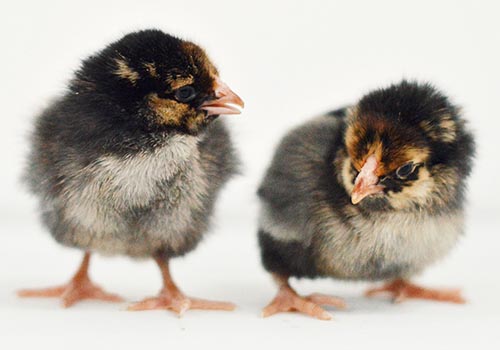
One of America’s most beautiful and beloved chickens, the Golden Laced Wyandotte is hard to mistake with its stunning plumage. The breed was created in the 1880s by poultry farmers who were looking for a homegrown dual-purpose chicken. They tend to be talkative and friendly with their handlers. Wyandottes have a small rose comb, which makes them perfect for cold climates because they are not prone to frostbite. Their thick feathering keeps them warm in winter making them very cold hardy, but summertime can be brutal for them; they need shade and cool water to maintain their comfort and avoid heatstroke.
These great chickens lay about 200 eggs per year, or 4 per week. This makes them very attractive for backyard flocks. They do have a tendency to be broody, but this can be an asset if you would like to raise your own chicks. Typically the roosters mature to 8.5 lb and the hens mature around 6 lb.
Blue Laced Red Wyandotte and Black Laced Red Wyandotte
The original development of these came from crossing Silver Laced and Golden Laced varieties of Wyandottes; after a lot of work, the Blue Laced Red and Black Laced Red Wyandottes were developed from this cross. They carry over many of the great physical and personality traits of those breeds and mature around 6.5 lb. The Black Laced Red Wyandotte chicken has dark red-brown or mahogany feathers that are laced around the edges with black. The Blue Laced Red will color either light blue or dark blue in the lacing (the area around the reddish colored feathers) in both the baby chicks and the mature birds. You may have birds that vary somewhat in appearance but still display the beautiful colors of this very rare and unusual chicken.
Mature Wyandottes hens lay about 200 medium-sized brown eggs each year. They are a hardy breed for cold weather months, but like other Wyandottes, need some shade in the summer to avoid heatstroke. They have a strong personality like their relatives so they’re usually near the top of the pecking order, yet docile with their keepers. Wyandottes are usually known to be talkative and friendly.
Blue Laced Gold Wyandottes
The original development of this breed came from crossing Silver Laced and Golden Laced varieties of Wyandottes. Eventually, the Blue Laced Gold Wyandotte was developed from this cross. They carry over many of the great physical and personality traits of those breeds and the hens mature around 6.5lb. The blue gene will color the chicks either light blue or dark blue in the lacing (the area around the gold-colored feathers) in both the baby chicks and the mature birds.
Mature Blue Laced Gold Wyandottes lay about 200 medium-sized brown eggs each year and are medium in size. They are a hardy bird for cold weather months, but like other Wyandottes, need some shade in the summer to avoid heatstroke. They have a strong personality like their relatives so they’re usually near the top of the pecking order, yet docile with their keepers.
Columbian Wyandotte

The Columbian Wyandotte, unlike its laced counterparts, are mostly solid white with a distinguished “collar” of black feathers adorning its neck and black tail-feathers poking out amongst the white. Like the other Wyandottes, they have rose-colored combs that lay flat, and very close to the chicken’s head, making them well-suited to withstand the wind chills and frostbite in some of the colder regions. This Wyandotte is a medium to large chicken that typically weighs in around 7 lb, making it an excellent meat chicken for those looking for a dual-purpose breed.
On average, a healthy hen can lay around 200-250 medium-sized light brown eggs per year, and, since they are very cold hardy, will continue to lay during the winter months. Columbian Wyandottes love to forage around the yard, and prefer to eat most of their meals outside of the coop. They tend to be the last ones in the coop at night. Columbian Wyandottes are usually great chickens for beginners because of their docile temperament, excellent foraging abilities, and cold-hardiness. They are one of the most beautiful dual-purpose breeds available and are fantastic for those living in colder climates.
Buff Brahmas, Dark Brahmas, and Light Brahmas
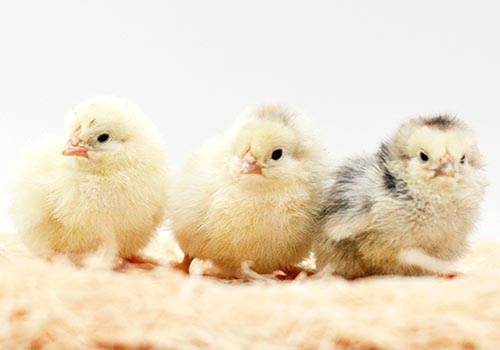
The first Brahmas were brought to the United States from India in 1846. Known as the “King of Chickens,” they are famed for their size. Brahmas are a docile, calm breed that is both a meat and egg-laying bird. They have feathered legs and are very suitable for cold climates. Brahmas prefer to lay October-May, laying about 3-4 eggs a week. The standard weight for a rooster is 11-18 lb; hens mature to 8-13 lb. The roosters are calm and generally not aggressive towards humans. Most Brahmas are not skittish or easily scared, making them a popular choice for families with children. Due to their docile demeanor, Brahmas can be easily trained so that they can be handled by almost anyone, making them great for 4-H projects. They do not fly well so are fairly easily contained. Although they tolerate confinement they also do very well as foragers.
Buff Chanteclers and Partridge Chanteclers
The Chantecler is the only chicken breed developed in Canada. The Chantecler was bred for great laying abilities as well as traits that would make them very hardy for the cold Canadian winters. They are a gentle, hardy, dual-purpose breed with hens weighing in around 6-7 lb and laying 210 pale brown eggs a year. An excellent meat bird, roosters can weigh up to 8.5 lb. The combination of their small comb and wattles with their meaty bodies and thick feathers make them a great choice for the colder northern climates. The Chantecler is a friendly breed, however, does not enjoy confinement. Today they are exceedingly rare throughout North America, but hatcheries are beginning to sell them in small numbers. If you live in the northern United States, this is a great breed to consider for your home flock.
Buff Orpington
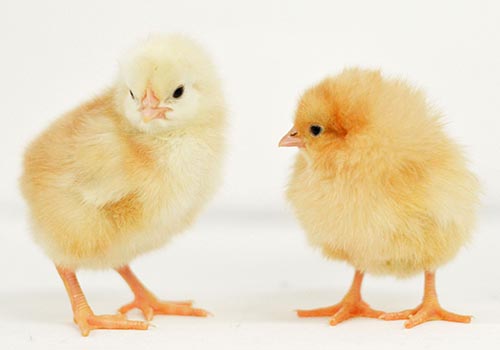
In 1886, William Cook unveiled the first Orpington breed. Many different colors of the breed followed, including the Buff Orpington. All Orpingtons are said to be docile and friendly, but this is especially true of the Buff. They are very calm and stately—they sort of glide across the barnyard. They love to be cuddled and will often seek you out to let you know they need attention. Their fabulous feathering makes them very cold hardy, although, if their feathers get soaked they can chill and die quickly. They tolerate warmer climates but need to have access to shade during the heat of the day.
They make great mothers, they will usually accept hatching eggs being placed under them. The Buff roosters are said to be fiercely protective of their offspring. They are reliable layers of large, brown eggs, laying around 200-280 per year. If you are raising them as a meat bird, they are table ready at around 22 weeks. Roosters will mature around 10lbs and hens mature around 8 lb. They are often considered the perfect dual-purpose chicken. If you are looking for a big, fluffy chicken that lays well, has a sweet disposition, and tolerates small children, this may be your choice!
Chocolate Orpington
The Chocolate Orpingtons were first bred in England in 1993 by Dr. Clive Carefoot. They have a similar body shape to Buff Orpingtons but are a rich chocolate brown. Like their relatives, they love to be cuddled and will often seek you out to let you know they need attention. Their feathering makes them very cold hardy; they also tolerate warmer climates but need to have access to shade during the heat of the day.
They are reliable layers of large, brown eggs, laying around 200-280 per year. Roosters will mature around 10 lb and hens mature around 8 lb. If you are looking for a big, fluffy chicken that lays well, has a sweet disposition, and tolerates small children, this may be your choice!
Red Orpington
The Red Orpington was created by W. Holmes Hunt around 1900. Both the roosters and hens have a solid, dark mahogany coloring, however, roosters can sometimes have black tips in their tail feathers. Red Orpington hens are also one of the more prolific layers among the breed, which may be due to the possible use of Sussex and Rhode Island Reds in the creation of the color.
Lavender Orpington
The Lavender Orpington is a relatively new member of the Orpington family. They have all the wonderful features of the Buff Orpington, combined with impressive coloring. With their blue-lavender color tone and docile Orpington personality, these chickens have become one of the most sought after breeds by enthusiasts. Lavender Orpingtons have a similar body shape and demeanor to Buff, Red, and Chocolate Orpingtons. They lay about 200-280 large brown eggs per year.
Cinnamon Queen
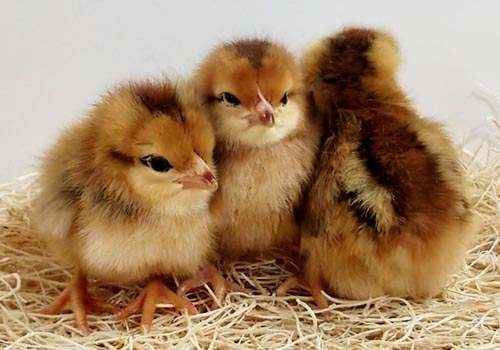
Like several other sex-linked breeds, Cinnamon Queen Chickens were developed to meet the needs of modern flock keepers. Most people who keep chickens are looking for excellent egg production, and Cinnamon Queens certainly deliver. Cinnamon Queens are a cross of a Rhode Island Red male and the Rhode Island White female. They are almost identical to Golden Comets, but they are two different genetic strains and some prefer one over the other.
While Cinnamon Queens are raised primarily for their egg-laying abilities, they can also be raised for meat. They have compact, heavy bodies. Hens mature around 5.5 lb and will lay between 250-300 large, brown eggs annually. The Cinnamon Queens have a reputation as being particularly sweet and docile birds. Many owners say they are the sweetest members of the flock.
Delaware

Developed in 1940, the Delaware is a relatively new breed of chicken. They are a cross between New Hampshire Reds and Barred Plymouth Rocks with the goal of maintaining the prolific egg production of these two breeds but increased meat value. The Delaware is a medium-sized, dual-purpose bird with a long, broad, and deep body. The roosters mature around 7-8 lb and the hens around 6 lb. Delawares are excellent layers, laying about 200-280 jumbo brown eggs per year.
They have black feathers around the neck and the tip of the tail, with some black striations also working their way into the back. Delawares have been described as calm, friendly, curious, and intelligent. The Delaware is well suited for the small urban/suburban homesteads.
Dixie Rainbows
The Dixie Rainbow is a dual-purpose bird that has one of the most unique feather color patterns you will ever see. It has every color you can imagine, and no two birds look alike. The best part about this breed is that they make wonderful birds for small backyard flocks giving you the opportunity to use them for meat or keep the hens for eggs! They reach market weight at around 12 weeks. Hens mature around 7 lb and will lay approximately 250 medium brown eggs each year. Due to Dixie Rainbows being a dual-purpose bird, they grow excessively quickly. Usually, they are weeks ahead of growth compared to other breeds the same age.
Dixie Rainbows do well confined or free-range, so most any lifestyle will suit these birds. They are cold hardy, so New England weather doesn’t bother them. Many Dixie Rainbows are affectionate and are sweet birds. They are known to be vocal and like to chirp and talk to their owners. They get along with other birds well and aren’t aggressive.
Mystic Onyx
Originally developed as a meat bird similar to Asian Black chickens, the Mystic Onyx is a hybrid breed that came from crossing meat birds with Silkies. Because of this, they have some Silkie characteristics, the Mystic Onyx has 5 toes and has dark skin, beaks, combs, and meat, if processed. They commonly showcase orange-red flares in their plumage which contrasts with the iridescent green undertones. The hens weigh 6-7 lb and are layers of light brown eggs, producing an average of 225 eggs per year. These are active birds that are both cold and heat-hardy. The Mystic Onyx hens are rarely broody.
New Hampshire Red
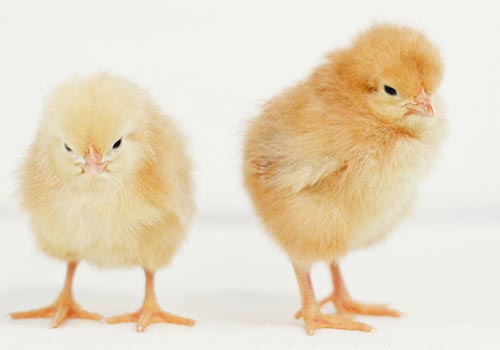
Around 1910 or so, poultry breeders of New Hampshire were selecting hens for faster feathering, faster growth, and maturity from the Rhode Island Red strains that were around at the time. The honor of creating this breed went to Professor ‘Red’ Richardson. The selective breeding intensified the characteristics of early maturity, rapid full feathering, and production of large brown eggs. The mature birds are a rich chestnut red, of a somewhat lighter and more even shade than the Rhode Island Reds and the baby chicks are also a lighter red.
The New Hampshire is a good egg layer of around 200 large tinted/light brown eggs per year. They also can go broody fairly frequently; if allowed to hatch their own they make great mothers too. The New Hampshire is a family-friendly bird, making great pets as they are easy to tame. New Hampshire Reds will tolerate confinement but do like to free-range. If allowed to free-range, this will help reduce your feed bill since they are good foragers.
They are said to be a people-friendly, intelligent bird that is reliable, cold, hardy and robust. In addition, they will tolerate hot weather but need shady spots to hide in. They generally will live up to seven years and weigh around 8lbs for the roosters and 6 lb for the hen. These birds are a great choice for beginners! If you are looking for a dual-purpose, all-around bird for the family, the New Hampshire Red could be your breed.
Salmon Faverolles

Salmon Faverolles originated in a small village of Faverolles, France. Their genetic composition is believed to be a mix of Houdan, Brahma, French Rennes, Flemish Cuckoo, Malines, and Dorking chicken. French farmers were looking for a hen that fleshed out well for the market and also laid a good amount of eggs. They are bearded giving them a fluffy looking face. Once mature, a hen will weigh about 6.5 lb, with a rooster weighing 8 lb.
They are good layers of light brown, medium-sized eggs. They lay an average of 180-200 eggs per year. Salmon Faverolles are near the bottom of the pecking order, so housing with less aggressive breeds is best for them. Faverolles are a very cuddly and lovable hen and they enjoy talking with you. This is a very gentle bird that does very well with children, even the roosters are said to be mellow and non-aggressive. These chickens are good layers and lay well through winter.
Silver Gray Dorking
The Dorking is one of the oldest known chicken breeds, possibly dating back to 43 AD; they are also endangered! The Dorking is a stout breed, used for meat and eggs with mature hens weighing in at 8 lb. They are known to have shorter legs than other large breeds. They are stocky, making them an ideal meat breed. The meat is tender, light, and flavorful. The Dorking comes in white and silver-grey color varieties, both of which are lovely additions for those who enjoy an ornamental flock.
The comb of the Dorking is large and sometimes looks to be a tad floppy on the roosters, which gives the breed a somewhat comical appearance. While the large comb is bright, red, and beautiful, it is not well-suited for extremely cold environments. They even have five toes instead of the usual four. Dorkings are also the only breed with a red earlobe to lay a white egg.
They are one of the few chickens that produce consistently throughout the winter, rather than slow down like some breeds. The Dorking’s eggs are considered white or creamy and medium to large in size. These hens can lay around 170-190 eggs per year. Dorkings love to forage your property for bugs, weeds, and they tend to stick close to home. If you are willing to help an endangered species and have some great quality birds, these are the chicks for you!
Speckled Sussex
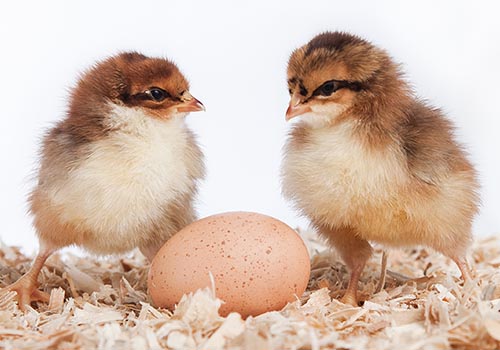
The Speckled Sussex is an old-time favorite in its homeland of England. It has endured over the centuries to become a perennial favorite in the United States as well. The feathers of the Speckled Sussex all have a mix of mahogany and black with white tips. The number of white tips increases as the bird molts each year.
The speckled Sussex is an excellent layer, averaging 4-5 large, brown eggs per week. They are reputed to lay well through the winter months perhaps taking only a pause for the molt. The Speckled Sussex Chickens have a tendency towards broodiness, they set well and make fine mothers. When raised as a meat bird, the Sussex dresses out at a very decent 7 lb for hens and 9 lb for roosters. The taste of the meat is exceptional although the American market generally prefers a slightly darker color of meat.
The Speckled Sussex is quite a robust bird tolerating a wide variety of circumstances from free-range to confinement. They tolerate the cold very well but do not like the heat because their feathers are quite dense. They are friendly and docile hens that are well suited for small children and families. These birds also enjoy chatting with you, they can become firm family favorites and even enjoy lap time with you. The speckled Sussex is a mellow bird and is very suitable for farming or as a 4-H project for young poultry enthusiasts.
Welsummer

Remember Cornelius (The Kellogg’s rooster)? He is a Welsummer rooster! The breed was created around the village of Welsum near Deventer, the Netherlands, as a dual-purpose bird in the post-World War One era. Their coloring is dark brown with light brown/white feather shafts, while the neck and nape feathers are a golden brown color with darker brown shading. Their coloring has been known to help camouflage them from predators. Welsummers prefer the cooler weather, so are good for chilly Northern climates, but they will tolerate heat as long as they have somewhere cool to go to. Hens will lay up to dark, rich, terracotta brown 250 eggs per year.
Welsummers are one of the top 10 foraging chicken breeds and are not great flyers, so they can be easily confined with minimal fencing. They are intelligent birds. The roosters are especially docile and generally very safe to interact with. On the negative side, these birds can be noisy! They are the ones who shout the loudest when they feel something is upsetting them. These beauties are endorsed by Prince Charles; he has kept a flock of these birds for many years now.
Fast Facts
| Breed | Weight | Color of Eggs | Eggs Per Year | Living Conditions |
| Black Giant | 11 lb. | Brown | 180-250 | Free Ranging and Pastured Environments |
| Black Laced Red Wyandotte | 6.5 lb. | Light Brown | 200 | Confined Situations, Free Ranging, and Pastured Environments |
| Blue Laced Gold Wyandotte | 6.5 lb. | Light Brown | 200 | Confined Situations, Free Ranging, and Pastured Environments |
| Blue Laced Red Wyandotte | 6.5 lb. | Light Brown | 200 | Confined Situations, Free Ranging, and Pastured Environments |
| Buff Brahmas | 8-13 lb. | Brown | 150 | Confined Situations, Free Ranging, and Pastured Environments |
| Buff Chanteclers | 6-7 lb. | Light Brown | 210 | Confined Situations and Pastured Environments |
| Buff Orpington | 8 lb. | Brown | 200-280 | Confined Situations, Free Ranging, and Pastured Environments |
| Chocolate Orpington | 8 lb. | Brown | 200-280 | Confined Situations, Free Ranging, and Pastured Environments |
| Cinnamon Queen | 5.5 lb. | Brown | 250-300 | Confined Situations, Free Ranging, and Pastured Environments |
| Columbian Wyandotte | 7 lb. | Light Brown | 200-250 | Free Ranging and Pastured Environments |
| Dark Brahmas | 8-13 lb. | Brown | 150 | Confined Situations, Free Ranging, and Pastured Environments |
| Delaware | 6 lb. | Brown | 200-280 | Confined Situations and Pastured Environments |
| Dixie Rainbows | 7 lb. | Brown | 250 | Confined Situations, Free Ranging, and Pastured Environments |
| Golden Laced Wyandotte | 6.5 lb. | Light Brown | 200 | Confined Situations, Free Ranging, and Pastured Environments |
| Lavender Orpington | 8 lb. | Light Brown | 200 | Confined Situations, Free Ranging, and Pastured Environments |
| Light Brahmas | 8-13 lb. | Brown | 150 | Confined Situations, Free Ranging, and Pastured Environments |
| Mystic Onyx | 6-7 lb. | Brown | 225 | Confined Situations and Pastured Environments |
| New Hampshire Red | 6 lb. | Light Brown | 200 | Confined Situations, Free Ranging, and Pastured Environments |
| Partridge Chanteclers | 6-7 lb. | Light Brown | 210 | Confined Situations and Pastured Environments |
| Red Orpington | 8 lb. | Brown | 175-200 | Confined Situations, Free Ranging, and Pastured Environments |
| Salmon Faverolles | 6.5 lb. | Tinted White | 180-200 | Confined Situations, Free Ranging, and Pastured Environments |
| Silver Gray Dorking | 8 lb. | Cream | 170-190 | Confined Situations, Free Ranging, and Pastured Environments |
| Silver Laced Wyandotte | 6.5 lb. | Light Brown | 200 | Confined Situations, Free Ranging, and Pastured Environments |
| Speckled Sussex | 7 lb. | Light Brown | 250 | Confined Situations, Free Ranging, and Pastured Environments |
| Welsummer | 5.5 lb. | Terracotta | 250 | Free Ranging and Pastured Environments |
At The Cheshire Horse, we are proud to be your full-service poultry and farm supply store. If you have any questions regarding the various breeds of chicks that we carry, we encourage you to speak with a member of our friendly and knowledgeable sales staff. We would love to help you select the right chicks to join your homestead.
